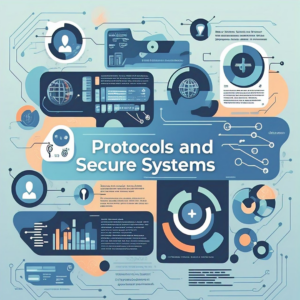Protocols and Secure Systems in Networking for Cloud Security
1. Introduction to Protocols and Secure Systems in Networking
Protocols and secure systems in networking play a crucial role in ensuring cloud security and data protection. In modern computing, network protocols define the rules for communication, ensuring data integrity, authentication, and encryption. Secure systems rely on these protocols to prevent cyber threats and unauthorized access, making them essential for cloud infrastructure security.
2. Types of Protocols
2.1 Transmission Control Protocol (TCP): TCP is a connection-oriented protocol that guarantees reliable data transmission. It ensures that data packets are received in order and without errors, making it ideal for web browsing, email, and other applications where data accuracy is essential.
2.2 User Datagram Protocol (UDP): UDP is a connectionless protocol that prioritizes speed over reliability. It is commonly used in real-time applications such as video streaming and online gaming, where occasional data loss is tolerable.
2.3 Internet Protocol (IP): IP handles packet addressing and routing across networks. It operates in two versions: IPv4, which has limited address space, and IPv6, which was introduced to resolve the exhaustion of IP addresses.
2.4 Hypertext Transfer Protocol (HTTP): HTTP is the foundation of data communication on the World Wide Web. It specifies how web servers and browsers exchange information, enabling seamless access to websites.
2.5 File Transfer Protocol (FTP): FTP enables file transfers between clients and servers. It supports both anonymous and authenticated access for secure data sharing over networks.
2.6 Secure Sockets Layer (SSL)/Transport Layer Security (TLS): SSL and its successor, TLS, encrypt data transmitted over networks, ensuring secure online transactions and user privacy in cloud environments.
3. Secure Systems in Computer Networks and Disaster Recovery
Security in computer networks is critical, especially in cloud computing, where systems are vulnerable to cyber threats. Secure systems help prevent unauthorized access, data breaches, and denial-of-service (DoS) attacks. They also ensure data integrity, confidentiality, and availability, which are essential for disaster recovery planning.
4. Key Security Concepts
4.1 Authentication
Authentication verifies the identity of users or devices before granting access to the network. It includes methods such as passwords, biometrics, and digital certificates.
4.2 Authorization
Authorization determines which resources a user or device can access after authentication. It is managed using access control lists (ACLs) and role-based access control (RBAC).
4.3 Encryption
Encryption converts data into a secure format to protect it from unauthorized access. Only users with the correct decryption key can access the original data.
4.4 Firewalls
Firewalls act as protective barriers between secure internal networks and external threats. They monitor traffic and enforce security rules to prevent cyberattacks.
4.5 Intrusion Detection Systems (IDS)
IDS solutions analyze network traffic to detect and respond to potential threats. They alert administrators in case of suspicious activity.
4.6 Virtual Private Networks (VPNs)
VPNs establish encrypted connections over the internet, allowing remote users to access corporate networks securely.
5. The Role of Protocols in Network Security in Cloud Computing
Protocols are vital for securing cloud computing environments. They define the rules for safe data transmission and establish frameworks for authentication, encryption, and access control. By leveraging secure protocols, organizations can ensure compliance with cybersecurity standards.
6. Secure Protocols
6.1 Secure Hypertext Transfer Protocol (HTTPS)
HTTPS is a secure version of HTTP that employs SSL/TLS encryption. It ensures safe communication between web browsers and servers, protecting sensitive data.
6.2 Secure File Transfer Protocol (SFTP)
SFTP is a secure alternative to FTP that uses Secure Shell (SSH) encryption for data transmission. It enhances the security of file transfers.
6.3 Internet Protocol Security (IPsec)
IPsec encrypts and authenticates IP packets, making it an essential component of VPNs and secure network communications.
6.4 Transport Layer Security (TLS)
TLS is the successor to SSL and is widely used in secure online communication. It encrypts data and ensures the integrity of transmitted information.
7. Challenges in Network Security
7.1 Evolving Threat Landscape
Cyber threats are constantly evolving, requiring organizations to stay updated with security patches and implement proactive defense measures.
7.2 Human Error
Many security breaches occur due to weak passwords, phishing attacks, or misconfigurations. Educating employees about security best practices is essential.
7.3 Complexity of Networks
Modern networks consist of multiple interconnected systems, making security implementation challenging. Organizations must adopt a comprehensive security approach.
7.4 Compliance Requirements
Businesses must adhere to various cybersecurity regulations, such as GDPR and HIPAA, to protect user data and maintain compliance.
8. Future Trends in Protocols and Secure Systems
8.1 Increased Use of Artificial Intelligence (AI): AI-driven security solutions analyze vast amounts of data to detect anomalies and prevent cyber threats more efficiently.
8.2 Zero Trust Security Model: The Zero Trust model requires strict authentication for all users and devices, assuming that threats exist both inside and outside the network.
8.3 Blockchain Technology: Blockchain enhances security through decentralization and cryptographic encryption, making it suitable for secure transactions and identity management.
8.4 5G and IoT Security: The expansion of 5G networks and IoT devices introduces new security challenges, requiring advanced protocols to mitigate risks.
8.5 Quantum Cryptography: Quantum cryptography offers future-proof encryption methods that leverage quantum mechanics principles to protect sensitive data.
Conclusion
Protocols and secure systems are fundamental to network security. They enable reliable communication while protecting sensitive information from cyber threats. As technology continues to evolve, organizations must stay ahead by adopting the latest security measures.
Understanding protocols and secure systems in networking is essential for businesses looking to strengthen their cloud security. By leveraging modern security technologies, organizations can enhance protection, ensure compliance, and mitigate cyber risks.
Do you like to read more educational content? Read our blogs at Cloudastra Technologies or contact us for business enquiry at Cloudastra Contact Us.
